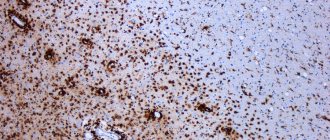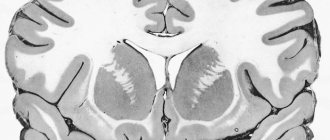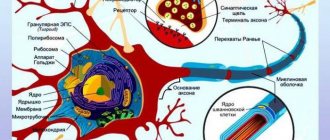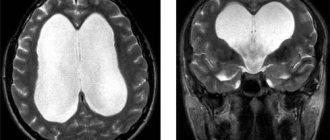Multiple sclerosis is a pathology of the nervous system, which was previously considered incurable, but is now recognized as completely conquerable. A stem cell transplant for multiple sclerosis offers a chance for recovery. This innovative technique is not recognized in all countries.
However, it has already proven itself to be excellent - after the operation, people’s quality of life improves significantly. In the future, the issue of widespread introduction of this method of treating multiple sclerosis is being considered.
Causes and provoking factors
For a more complete understanding of how to choose the optimal treatment regimen for multiple sclerosis - whether it will be possible to perform a stem cell transplant, the doctor initially finds out the reason why the disease developed.
Experts have not reliably established why people develop multiple sclerosis. Most often the following provoking factors are indicated:
- genetic predisposition - if relatives have already had cases of multiple sclerosis, then the child may well develop the disease;
- excessive intellectual stress – work activity associated with the risk of psychological instability and severe stress;
- weakened immune system – frequent infections, especially those affecting brain structures;
- autoimmune diseases - the body perceives its own tissues as foreign, and produces protective cells against them, so there is a chronic inflammatory process that undermines the nervous system;
- bad habits – multiple sclerosis is observed in people whose experience of abusing alcohol and tobacco products exceeds 20-30 years.
Some experts consider a person’s residence in the northern regions and his attitude towards the white race to be provoking factors for multiple sclerosis.
What is multiple sclerosis?
Multiple sclerosis (MS) is an autoimmune disease in which the body begins to attack its own myelin sheath. The myelin sheath covers and protects neurons in the brain, but it is also an important part of the function of the nervous system. The shell is an electrical insulator that speeds up the process of electrical signals passing through neurons. When the myelin sheath is damaged, it can seriously slow down the process of information transfer. As a result, MS patients suffer from a variety of different symptoms, including numbness, mobility and motor problems, fatigue, and more.
Symptoms and signs
To begin treating a disease, you first need to recognize it. Since the pathology is based on damage to the nerve fibers along which impulses travel from the brain to the internal organs, the clinical picture will depend on in which part of the body the pathological focus has formed.
Manifestations of multiple sclerosis:
- trembling of the limbs - at first barely noticeable and periodic, it intensifies as the disease progresses, becoming widespread and prolonged;
- disturbance of the perception of the body in space - when moving, the feet seem to lose the feeling of solid ground, “walking on wobbly legs”;
- coordination of movements loses its clarity - from the outside a person may seem drunk;
- loss of control over the facial nerves - part of the face shifts to one side;
- tingling in certain areas of the skin - a feeling of numbness;
- pathological strengthening or weakening of muscle tone;
- failure in the process of urination - most often due to incontinence.
Neurological symptoms will be expressed in changes in the patient’s mood, tearfulness or euphoria, attacks of depression and decreased self-esteem.
Before deciding whether a stem cell transplant is permissible, the doctor must conduct a thorough neurological examination and instrumental studies of the nervous system.
How does stem therapy help with MS?
Multiple sclerosis is a disease characterized by damage to nerve fibers, their inflammation and scarring. In this regard, the function of the pathways is disrupted, pain, muscle paralysis, and autonomic disorders occur.
The main symptoms of multiple sclerosis include:
- Immobilization of individual muscles or entire groups of them. Paralysis can be either spastic or flaccid.
- Loss of hearing and vision.
- Dizziness, imbalance.
- Pain in joints and muscles.
- The appearance of a feeling of numbness of the skin, goosebumps.
- Double vision.
- Urinary and fecal incontinence.
- Memory disorder.
It is useful to read what exercises for multiple sclerosis are indicated for patients.
All about dietary supplements for cerebral vessels in multiple sclerosis.
Many violations are irreversible and cannot be restored. Therefore, there is a need for new treatment methods because:
- Medicines used for multiple sclerosis (immunosuppressants, glucocorticoids) have serious side effects, sometimes life-threatening. For example, septic complications.
- Drug treatment only slows down the development of the disease, stops it, but does not lead to the restoration of the affected, healed nerve fibers.
However, medical science does not stand still, so stem cell transplants are now being performed for multiple sclerosis. This procedure gives hope for restoring the ability to work of seriously ill people.
Description of the transplantation technique
The uniqueness of stem cells is that they are already present in the human body and have the ability to differentiate into those areas of the body where they are located. In Russia, the transplantation technique for multiple sclerosis is standardized and officially approved.
Stem cell therapy for the disease leads to the restoration of the myelin sheath of the brain nerve fibers, which was damaged by foci of fibrous tissue. The transplantation technique also has a positive effect on the immune system, the state of which is important for the course of the disease.
Multiple sclerosis is treated with stem cells if previously carried out therapeutic measures - taking medications, physiotherapy, sanatorium-resort treatment - have not brought a significant improvement in the person’s condition. In this case, the collection of biomaterial for transplantation is carried out directly from the patient himself.
In this case, the risk is reduced:
- introduction of infections;
- provoking mutations in cells - the appearance of oncology;
- immunological mismatch.
In general, stem cell transplantation is a proven method that has previously been used to get rid of other diseases. It turned out to be promising for stopping pathological processes characteristic of multiple sclerosis.
When is this method used?
At the current time, there are no methods of therapy that would lead to a cure for the disease. But the diagnosis of multiple sclerosis is treatable and responds quite well to therapy.
The goal of therapeutic intervention is to stabilize the course of the patient’s pathology , as well as to prevent recurrent exacerbations.
During exacerbations, medications from the group of glucocorticosteroid hormones (suppression of the immune response to the cellular structures of one’s own body), as well as plasmapheresis, aimed at removing autoantibodies from the patient’s body, are widely used.
Interferons and monoclonal antibodies are also used for treatment, but their use is expensive.
Therefore, in order to treat this pathological process, a new therapeutic method is increasingly being used - high-dose chemotherapy with further bone marrow (stem cell) transplantation.
Stem cells are cellular structures that undergo differentiation to form different types of cells . These structures, localized in the red bone marrow, are called hematopoietic (hematopoietic).
The drugs used in polychemotherapy ensure the destruction of antibodies directed against the body's own structures (in the disease in question - the myelin sheath of the nerves), and subsequent transplantation provides a functional restructuring of the immune system, the result is a stable course of the pathology in patients and a decrease in the frequency of exacerbations.
Donation
A bone marrow donor can be a person in the age range from 18 to 45 years, who does not have any mental disorders or contraindications to the collection of stem cell structures.
Persons with:
- infectious pathologies: HIV infection, syphilis, viral hepatitis, tuberculosis, brucellosis, typhus, tularemia, leprosy;
- parasitic pathologies: toxoplasmosis, echinococcosis, filariasis, leishmaniasis;
- malignant neoplasms;
- hematological pathologies;
- diseases of the cardiovascular system: high-grade arterial hypertension, coronary heart disease, atherosclerotic lesions, obliterating arteritis, thrombophlebitis, heart defects, inflammatory diseases of heart tissue;
- diseases of the respiratory tract: bronchial asthma, obstructive bronchitis, emphysema, severe diffuse sclerosis;
- pathologies of the gastrointestinal tract: gastric and duodenal ulcers, Achilles gastritis;
- diseases of the biliary tract: cholelithiasis, chronic liver pathologies of various origins, cirrhosis of the liver;
- pathologies of the urinary system: damage to the renal tissue, nephrolithiasis;
- connective tissue diseases;
- pathological conditions of the endocrine system;
- pathologies of the ENT organs: severe purulent-inflammatory diseases, acute or during an exacerbation of the chronic type of course, ozena;
- diseases of the organ of vision: high myopia (myopia), trachoma;
- diseases of the skin: fungal infections, psoriasis, pustular diseases.
Hematopoietic stem cells can be collected in one of the following ways:
- From the bone marrow: under general anesthesia in a hospital setting, a puncture of the pelvic bone is performed using a special syringe. The duration of the operation does not exceed half an hour.
- From venous blood: a special medication is taken that promotes the release of hematopoietic cells into the systemic circulation, blood is taken from the vein, and it is processed with a special device that retains these cells. The rest of the blood is then transfused to the donor through a vein on the other limb.
Learn about lifestyle and nutrition with multiple sclerosis:
- do they take into the army with MS, do they give them disability;
- what exercises the patient needs, what is the importance of vitamins;
- what folk remedies and methods are used to treat the disease.
Stages of transplantation
The procedure for restoring the myelin sheath of a nerve fiber by transplantation is the main goal of therapy for multiple sclerosis, and is carried out in three stages. As a rule, specialists first assess the initial state of a person’s health and determine the stage at which the disease is located.
Then you need to obtain biomaterial for transplantation - stem cells. To do this, blood is taken from a person - through a standard intravenous system it enters a specially designed device. It is he who helps differentiate the necessary ones from hundreds of thousands of blood cells.
There may be a small number of them in the peripheral bed. Sometimes, to obtain the required volume, 3–4 procedures are performed. The cells are then frozen and stored until transplantation.
At the second stage of transplantation, it is necessary to destroy immune cells already damaged by the pathological process. In order to solve this problem, the following is introduced into the human body:
- immunosuppressive medications - suppress unhealthy immune system activity that damages the myelin fiber of nerve endings;
- anti-inflammatory drugs - reduce the severity and extent of inflammatory foci in both the brain and spinal cord.
The complex effect allows you to prepare the human body for further stem cell transplantation. They are defrosted in a special mode and then enter the bloodstream through the intravenous system. All stages of transplantation are carried out in specialized hospital clinics.
What are stem cells?
Unicellular animals, as their name suggests, have a body that consists of a single cell. This cell is universal: it can breathe, move, eat, and reproduce.
Humans are a complex multicellular organism. Each cell in our body, be it a neuron or a myocyte (muscle cell), has a specific structure and is “tailored” to perform strictly defined functions. She can’t do anything else and, if she left the body, she would soon die.
But there are also unspecialized cells - they are called stem cells. Each such cell can turn into a specialized one: immune, nervous or other.
In an embryo, stem cells are truly universal. Actually, by multiplying and specializing, they create the entire organism. In an adult, each stem cell is attached to a specific tissue, that is, it has partially lost its universality. In the adult body, different types of stem cells are needed to restore organs after damage and renew them as they wear out. As scientists learned about stem cells and their remarkable properties, ideas began to emerge on how they could be used in medicine.
What affects the outcome of treatment
In order for the treatment of multiple sclerosis with stem cells to produce a significant result - increasing the quality of life and improving the functioning of internal organs, a number of conditions must be met.
Even a 20-30% chance of transplant success is always better than nothing at all, which was a reality at the end of the 20th century in patients with multiple sclerosis.
Obtaining high transplant results is influenced by:
- stage of the disease;
- rate of disease progression;
- patient's age;
- tissue susceptibility to therapy;
- the presence of concomitant severe diseases.
Thus, people with the initial stage of multiple sclerosis have every chance of recovery if a stem cell transplant is performed in a timely manner. Regeneration of the myelin sheath of the nerve fiber after transplantation occurs much faster. The disease completely recedes.
Excellent results were demonstrated by people who had multiple sclerosis for no more than 7-8 years. After several transplantation sessions, even those areas whose damage was about 70-80% were restored.
If multiple sclerosis has a severe progressive course, then transplantation allows one to achieve a stage of long-term remission of the disease - mental activity improves, and movement disorders become less pronounced.
Reviews about the treatment of multiple sclerosis with stem cells
According to the woman who underwent such an operation by Novik A.A., her life has changed significantly. There was no longer any need to take treatment for multiple sclerosis, and the manifestations of the disease disappeared. The quality of life has increased significantly and is almost close to a healthy state.
Another review of an operation also carried out in Moscow. A 39-year-old woman suffered from multiple sclerosis for 4 years. The treatment used slightly alleviated the course of the disease, but the periods of time between exacerbations gradually began to decrease, and remission became shorter and shorter.
Doctors, based on data on the patient’s health condition and the severity of the current disease, decided on the need for surgery. Recovery after surgery lasted about 1.5-2 months; then the trembling of the arms and legs, which especially bothered the patient, significantly decreased, and mental and emotional balance was restored, the woman stopped suffering from early-stage enuresis, and confidence in her abilities appeared.
And there is a significant amount of such evidence, for this reason stem cell transplantation can be considered a real breakthrough in the method of treating this terrible disease.
Cost of treatment
Of course, prices for transplant procedures can vary significantly from one region to another. The final cost of the transplant will be influenced by:
- level of medical institution;
- the need for an expensive preliminary examination;
- number of stem cell collection sessions;
- conducting additional consultations with other doctors.
Thus, Moscow centers offer similar services at the highest prices - up to 700-800 thousand rubles for transplant courses. While in other regions the cost may be lower. In foreign clinics, such treatment for multiple sclerosis is even more expensive.
The final cost of the transplant will be affected by the price of each stage of treatment - stem cell collection, the use of immunosuppressive medications, as well as the transplant itself. Such treatment should be trusted to truly trusted clinics with extensive experience in the treatment of multiple sclerosis.
Risk of complications and rejection
When a patient’s own stem cells are introduced into the patient’s body—autologous transplantation—the risk that rejection will occur is extremely low. After all, the immune system will perceive them as “family.”
An exception may be people with autoimmune pathologies - for example, systemic lupus erythematosus. In this case, additional immunosuppressive medications will be required.
Complications during transplantation are possible:
- if the amount of biomaterial is incorrectly selected;
- proper sterility was not observed during the procedure;
- the body was not previously prepared - a high concentration of already damaged immune cells in the bloodstream;
- the interval between the stages of introducing stem cells is not maintained.
However, the highest risk occurs if the patient receives stem cells from another person . Even death is possible. Therefore, many medical centers do not practice such stem cell transplantation at any stage of multiple sclerosis.
Expected result - video
Stem cell therapy for multiple sclerosis is a huge step in the treatment of pathology. The results of transplantation in people are usually observed by the end of the second or third month.
Effects of transplantation:
- chronic fatigue is eliminated;
- trembling in the limbs decreases;
- the mental state is normalized;
- confidence in future health appears;
- symptoms of urinary incontinence disappear;
- speech gains coherence and clarity;
- gait becomes more confident.
With early diagnosis of multiple sclerosis and timely administration of stem cells, complete recovery is possible - the disappearance of foci without myelin in the nerve fiber.
It is possible to defeat multiple sclerosis thanks to the technique of stem cell transplantation. However, transplantation requires specialized equipment and highly qualified doctors. Therefore, you should not delay seeking medical help.
Additional Information
A qualitative change in life after such an operation, removal of the main manifestations of the disease and the ability to return to everyday normal life is the main result of the latest medical achievements in this area.
It should be noted that transplantation of these cells can be carried out with a solid positive result only when this material is taken from the patient himself - this eliminates the risk of serious complications, such as a genetic predisposition to cancer, the possibility of the body rejecting the transplanted cells.
The stem cell transplant itself is prescribed by a doctor if the patient has no other ways to improve or stabilize the situation - the treatment used brings very little relief or does not work at all.
Also an important point in determining how effective such an operation will be in each specific case, you should know that its greatest effectiveness is observed when the patient is under 50 years of age, as well as in the early stages of the disease.
If the disease is no longer in the first stage and is noticeably progressing, many functions of the body have already been completely and irreversibly lost (these include urination, defecation and movement), then surgery is no longer prescribed.











